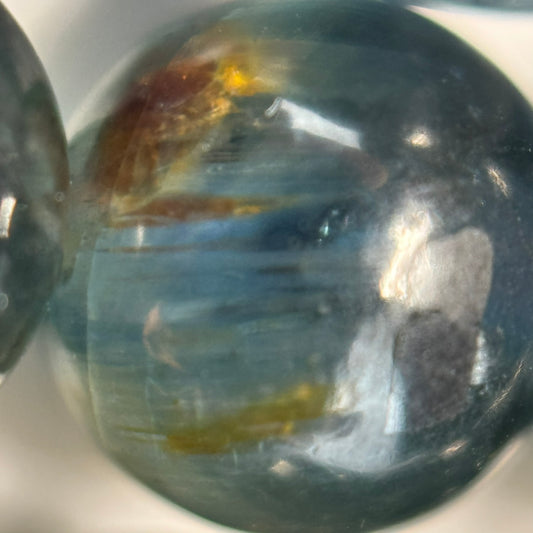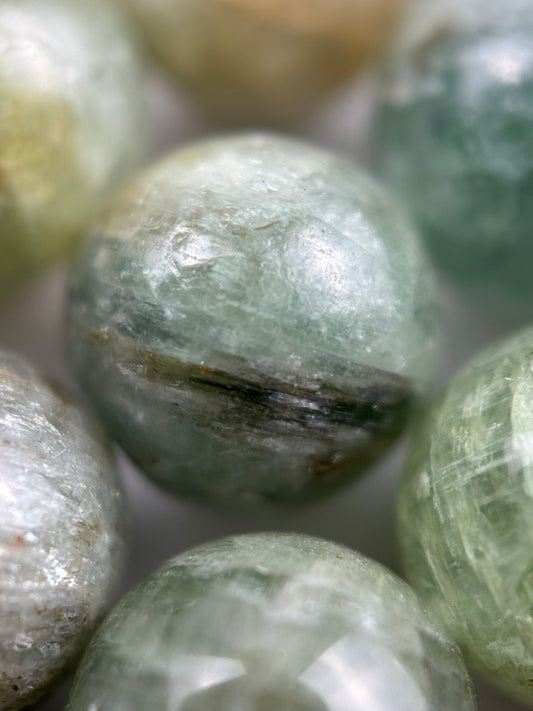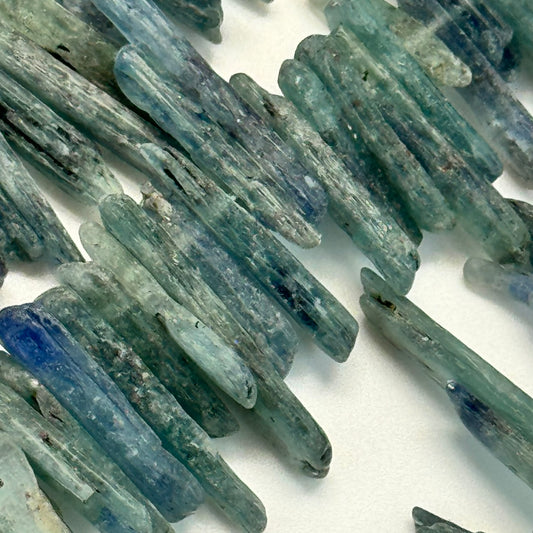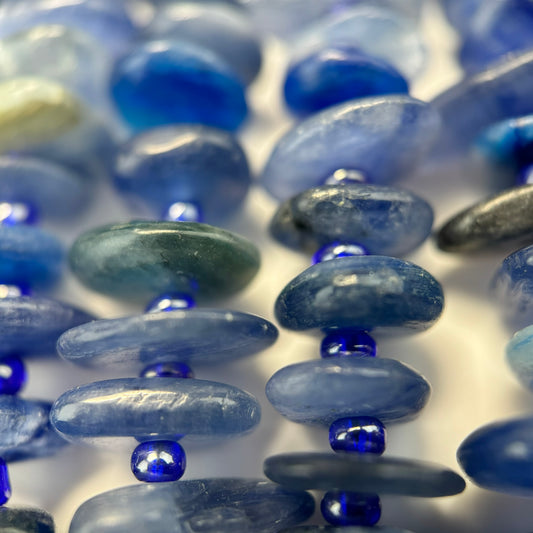Introduction to Kyanite Gemstone Beads
Kyanite is an aluminum silicate mineral known for its distinctive blue color and unique anisotropic properties. This gemstone displays different hardness values depending on crystal direction, making it both fascinating and challenging to work with.
Notable Features
- Distinctive blue coloration ranging from pale to deep
- Anisotropic hardness (varies by direction)
- Bladed crystal habit
- Pleochroism showing color variations
- Mohs hardness: 4.5-7 depending on direction
Chemical Composition and Crystal Structure
Kyanite has the chemical formula Al2SiO5 and belongs to the aluminosilicate group. It crystallizes in the triclinic system, forming elongated, bladed crystals.
Mineralogical Properties
- Chemical formula: Al2SiO5
- Crystal system: Triclinic
- Specific gravity: 3.53-3.67
- Refractive index: 1.712-1.734
- Birefringence: 0.012-0.017
Anisotropic Hardness Properties
Kyanite's most remarkable property is its anisotropic hardness. The stone is harder parallel to the crystal length (7 on Mohs scale) than perpendicular to it (4.5 on Mohs scale).
Hardness Characteristics
- Parallel to length: Mohs 7
- Perpendicular to length: Mohs 4.5
- Requires careful cutting orientation
- Affects durability in jewelry
- Important for lapidary work
Formation and Geological Occurrence
Kyanite forms in high-pressure, low-temperature metamorphic environments, typically in schists and gneisses. It's a key indicator mineral for certain metamorphic conditions.
Formation Environments
- Regional metamorphism of aluminum-rich rocks
- High-pressure, low-temperature conditions
- Schist and gneiss formations
- Contact metamorphism zones
- Pegmatite environments
Color Variations and Pleochroism
Kyanite displays various shades of blue, from pale sky-blue to deep sapphire-blue. The stone exhibits pleochroism, showing different colors when viewed from different angles.
Color Properties
- Primary color: Blue in various intensities
- Pleochroic colors: Blue, colorless, gray
- Some specimens show green or gray tones
- Color zoning may occur
- Transparency ranges from transparent to translucent
Cutting and Processing Challenges
Kyanite's anisotropic properties require careful cutting. The stone must be oriented correctly to maximize durability and visual appeal.
Cutting Considerations
- Orientation critical for durability
- Faceted cuts showcase pleochroism
- Cabochon cuts for uniform appearance
- Bead shapes require careful drilling
- Polish quality affects appearance
Durability and Wear Considerations
Due to its anisotropic hardness, kyanite requires protective settings and careful handling. The stone can be scratched or damaged if not properly oriented.
Durability Factors
- Variable hardness requires protection
- Susceptible to cleavage
- Protective settings recommended
- Careful storage important
- Not ideal for everyday wear without protection
Geographic Sources and Mining
Kyanite occurs in several locations worldwide, with notable deposits in Brazil, Nepal, Switzerland, and various locations in the United States.
Primary Sources
- Brazil: High-quality blue material
- Nepal: Fine gem-quality specimens
- Switzerland: Alpine deposits
- United States: Virginia, North Carolina
- India: Commercial quantities
Care and Maintenance Guidelines
Kyanite requires gentle care due to its variable hardness. Proper cleaning and storage practices help maintain its beauty.
Care Instructions
- Clean with warm soapy water
- Use soft cloth for drying
- Avoid ultrasonic cleaners
- Store separately to prevent scratching
- Protect from impacts
Jewelry Design Applications
Kyanite beads create elegant jewelry pieces, particularly when the stone's blue color and pleochroism are showcased. The stone works well in various design styles.
Design Uses
- Strand necklaces highlighting color
- Bracelets with protective settings
- Earrings showcasing pleochroism
- Combinations with complementary stones
- Formal and casual jewelry
Metaphysical Properties and Symbolism
Kyanite is associated with communication, self-expression, and alignment in various metaphysical traditions, adding to its appeal.
Symbolic Meanings
- Communication and expression
- Alignment of chakras
- Dream recall and intuition
- Calming and balancing energy
- Connection to higher consciousness
Comparison with Similar Blue Gemstones
Kyanite may be confused with other blue gemstones. Understanding its unique properties helps in identification.
Distinguishing Features
- Anisotropic hardness unique to kyanite
- Pleochroism different from sapphire
- Bladed crystal habit
- Lower specific gravity than sapphire
- Distinctive blue color tone
Frequently Asked Questions
What is the chemical composition and crystal structure of Kyanite beads?
Kyanite has the chemical formula Al2SiO5 (aluminum silicate) and belongs to the triclinic crystal system. It's a polymorph of andalusite and sillimanite, meaning all three share the same chemical composition but have different crystal structures formed under different pressure and temperature conditions.
What is the unique property of Kyanite's variable hardness?
Kyanite exhibits anisotropic hardness, meaning its hardness varies with crystal direction. Perpendicular to the long axis, Kyanite has a Mohs hardness of 4-5, while parallel to the long axis it has a hardness of 6-7. This directional hardness is unique among gemstones and affects how Kyanite must be cut and handled.
What causes the blue coloration in Kyanite gemstone beads?
The blue color in Kyanite is caused by trace amounts of iron (Fe2+ and Fe3+) substituting for aluminum in the crystal structure. The intensity of blue varies with the iron content and can range from pale blue to deep sapphire-like blue. Some specimens may show color zoning with different shades of blue.
What are the different color varieties of Kyanite and their causes?
Kyanite occurs in blue (most common), green (due to chromium or vanadium), orange (rare, due to manganese), gray, white, and black varieties. The blue variety is most valued, while green Kyanite (sometimes called chrome Kyanite) is rarer and often more expensive. Color variations result from different trace element substitutions.
What is the specific gravity and how does it vary in Kyanite?
Kyanite has a specific gravity ranging from 3.53 to 3.67, which is higher than most quartz-based gemstones. The specific gravity can vary slightly depending on the presence of inclusions and the crystal's orientation. This higher density gives Kyanite beads a substantial feel compared to lighter gemstones.
What are the primary geological sources and formation conditions of Kyanite?
Kyanite forms in high-pressure, low-to-moderate temperature metamorphic environments, typically in aluminum-rich rocks like schists and gneisses. Major sources include Nepal, Brazil, India, Myanmar, Kenya, and the United States (particularly North Carolina and Georgia). Nepalese material is often highly valued for its deep blue color.
How does Kyanite's perfect cleavage affect its use in jewelry?
Kyanite has perfect cleavage in one direction and good cleavage in another, making it prone to splitting along these planes. This requires careful cutting orientation and gentle handling. Beads must be cut to minimize exposure of cleavage planes, and jewelry designs should protect the beads from impacts that could cause cleavage.
What is the relationship between Kyanite and the aluminum silicate polymorphs?
Kyanite, Andalusite, and Sillimanite are polymorphs (same chemical formula Al2SiO5, different structures). Kyanite forms at high pressure, Andalusite at low pressure, and Sillimanite at high temperature. The presence of these minerals helps geologists determine the pressure-temperature conditions of metamorphic rocks.
What optical properties distinguish Kyanite from similar blue gemstones?
Kyanite has a refractive index of approximately 1.712-1.734, with birefringence of 0.012-0.017. It exhibits strong pleochroism, showing different colors (blue, colorless, or gray) when viewed from different angles. These properties, combined with its anisotropic hardness, help distinguish it from sapphire and other blue gemstones.
How does pleochroism affect the appearance of Kyanite beads?
Kyanite's strong pleochroism means the color intensity changes when the bead is rotated, showing different shades of blue or appearing nearly colorless from certain angles. This optical property adds visual interest but requires careful cutting orientation to maximize the most desirable blue color when viewed from the front.
What cutting challenges does Kyanite present for bead makers?
Kyanite's anisotropic hardness and perfect cleavage make it challenging to cut. The material must be oriented correctly to avoid splitting along cleavage planes, and the variable hardness means different parts of the same crystal require different cutting approaches. Careful handling is essential throughout the cutting and polishing process.
Can Kyanite be heat treated or enhanced?
Kyanite is typically not heat treated for gemstone use, as high temperatures can cause it to transform into Mullite or other phases, losing its gemstone properties. However, Kyanite is used industrially in refractory materials where it's intentionally heated. For jewelry, natural, untreated material is preferred.
What causes the color zoning sometimes seen in Kyanite beads?
Color zoning in Kyanite results from variations in trace element content (particularly iron) during crystal growth. Different growth zones may have different concentrations of coloring agents, creating bands or patches of varying blue intensity. This zoning is natural and can add character to the beads.
How should Kyanite beads be cleaned and cared for?
Clean Kyanite beads gently with warm, soapy water and a soft cloth, avoiding harsh chemicals or ultrasonic cleaners that could cause fracturing along cleavage planes. Store separately from harder materials to prevent scratching, and protect from impacts that could cause cleavage. Avoid sudden temperature changes.
What makes Kyanite beads unique among blue gemstone options?
Kyanite's combination of anisotropic hardness, perfect cleavage, strong pleochroism, and formation in high-pressure metamorphic environments makes it unique. Its variable hardness is particularly distinctive, and its deep blue color rivals sapphire while offering a more affordable alternative. Each bead requires careful cutting to maximize its natural beauty.







